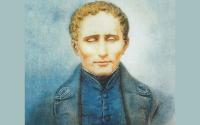Louis Braille
06 February 25
4 January 1809 – 6 January 1852
Braille became blind after an eye infection spread to both eyes.
When he was ten he won a scholarship for the National Institute for Blind Youth. Its founder Valentin Haüy had previously developed a system where ‘regular’ letters and numbers could be embossed into heavy paper. It became an ingredient in Braille’s eventual solution.
Another inspiration came from the unlikely source of Napoleon. He wanted his troops to be able to communicate messages at night without sound or light. ‘Night writing’ used a system of 12 small, embossed points , but was based on phonetics rather than regular spelling. It was too complex and cumbersome, but embossing was once more a key feature.
By the age of 15 Braille had simplified night writing and produced a system that not only used regular spelling, but reduced the tactile figures to just six points – each ‘cell’ comprising two columns of three dots. It also included a way to read and write music. This was all explained in his book published in 1829. The title wasn’t short: ‘The Method of Writing Words, Music and Plain Songs by Means of Dots, for Use by the Blind and Arranged for Them.’
The new system was slow to catch on, becoming generally used only within his own school by students and teachers.
Sadly Louis Braille died without ever seeing his system finally adopted in 1854.
After losing his battle with tuberculosis in 1852 he was buried alongside his father and sister in the town of his birth – Coupvray, a little east of Paris. The engraving on his tomb describes him as the ‘Inventor of raised point writing for the blind’.
To mark the centenary of his death in 1952, the French State honoured his memory by moving his body to the Pantheon in Paris – there to lie in the crypt alongside other great heroes of France such as Victor Hugo, Voltaire, Émile Zola, etc.
An interesting and perhaps lesser known fact is that the people of Coupvray insisted on retaining something of their famous son. So most of Louis Braille now reposes in the Pantheon; his hands however are sealed in an urn on his original grave in Coupvray


